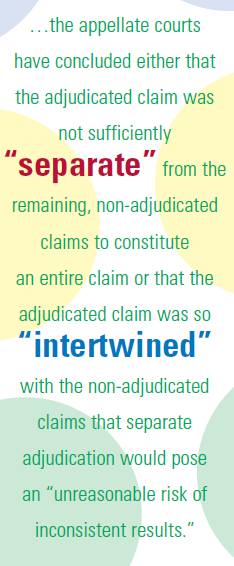Rule 54(b) Orders: Are They Losing Their Appeal?
| Publication year | 2010 |
| Pages | 0278 |


Over the past several years, appeals from Rule 54(b) orders are being dismissed with increasing frequency as not appropriate for Rule 54(b) certification. In doing so, the appellate courts have concluded either that the adjudicated claim was not sufficiently "separate" from the remaining, non-adjudicated claims to constitute an entire claim or that the adjudicated claim was so "intertwined" with the non-adjudicated claims that separate adjudication would pose an "unreasonable risk of inconsistent results." The decisions seem to be raising the procedural bar to appellate review of certified "final" orders in a manner inconsistent with historical practice. Perhaps this trend is understandable in light of the increasing appellate case load and the consequent delays in final resolution of litigation as a result of "piecemeal" appellate adjudication. Nonetheless, as these decisions multiply, sometimes without much analysis, and sometimes without consistent application, uncertainty escalates at the trial level as to (1) whether a particular dispositive ruling is capable of being certified under Rule 54(b) and (2) whether the appellate courts will in fact agree that it was properly certifiable. Because these issues affect the courts' appellate jurisdiction, the appeal can be dismissed ex mero motu, even though all parties desire immediate appellate resolution.
The three prerequisites for Rule 54(b) certification are (1) an action involving separate claims; (2) a final decision as to at least one of these claims; and (3) a determination by the trial court that there is "no just reason for delay." Scrushy v. Tucker, 955 So.2d 988, 996 (Ala. 2006)(quoting Stearnes v. Consolidated Management, Inc., 747 F.2d 1105, 1108 (7th Cir. 1984). The first two issues-whether the action involves separate claims and whether there is a final decision as to at least one of the claims-are "questions of law" to which the court applies a de novo standard of review. Id. The third prerequisite-whether there is "no just reason for delay"-is an inquiry committed to the sound discretion of the trial court and, on appeal, reviewed on the standard of whether the trial court "exceeded" that discretion. Id.1 The first two prerequisites require the complete adjudication of a claim for relief that is "separate" from all other non-adjudicated claims in the case. The third prerequisite gives rise to a number of considerations, most frequently whether the adjudicated and non-adjudicated claims are so "intertwined" as to pose "an unreasonable risk of inconsistent results."
Requirement for Complete Adjudication of Separate Claim
The requirement, under Rule 54(b), that a claim be disposed of in its entirety is a familiar one, precluding certification for interlocutory orders that do not fully resolve all the issues relating to that claim. Thus, non-certifiable orders include rulings of liability on monetary claims without awarding damages, see State v. Brantley, 976 So.2d 996 (Ala. 2007); Automatic Sprinkler Corp. of America v. B. F. Goodrich Co., 351 So.2d 555, 557 (Ala. 1977); or determinations that some of the damages sought on a claim are non-recoverable without ruling on liability; see Certain Underwriters at Lloyd's London v. So. Nat. Gas Co., 939 So.2d 21 (Ala. 2006); Ex parte Simmons, 791 So.2d 371 (Ala. 2000); Haynes v. Alfa Fin. Corp., 730 So.2d 178, 181 (Ala. 1999); or the entry of only injunctive relief on a claim that also sought money damages, see Martin v. Phillips, 2008 WL 4683634 (Ala. Civ. App. Oct. 24, 2008); or the resolution of several, but not all, of the issues necessary to adjudicate a claim for declaratory relief as to whether or not coverage exists for a particular claim, see Alfa Mutual Ins. Co. v. Bone, 2009 WL 51298 (Ala. Sup. Ct. Jan. 9, 2009); or, finally, an adjudication of an alter ego relationship without determining liability. See Banyan Corp. v. Leithead, 2009 WL 4730808 (Ala. S. Ct. Dec. 11, 2009).
A less familiar aspect of the "complete adjudication of a separate claim" requirement arises where a particular cause of action is fully adjudicated but is deemed not to be sufficiently "separate" from one or more of the non-adjudicated causes of action and thus not an entire "claim" for relief. A case may involve multiple, separate claims (to which Rule 54(b) is applicable) or a single claim supported by multiple grounds (to which Rule 54(b) is not applicable). Even when the case does involve multiple, separate claims, difficulties can arise in determining whether an order resolves the entirety of one of those claims, as Rule 54(b) requires, or leaves parts of that claim unresolved, i.e., other causes of action that simply set forth alternative theories of liability for that same "claim." These distinctions are often "very obscure." 10 Wright & Miller, Federal Practice & Procedure, § 2657.
The Supreme Court of Alabama first wrestled with the issue of what constitutes a "claim for relief" under Rule 54(b) in Cates v. Bush, 293 Ala. 535, 307 So.2d 6 (1975). In that case, the plaintiff sought the sale of land and the defendant's counterclaim sought an accounting based upon a claim of an interest in the land since 1952. In determining whether a judgment on plaintiff's claim could be certified under Rule 54(b), without adjudication of the counterclaim, the court adopted the following test used by the Second Circuit: "The ultimate determination of multiplicity of claims must rest in every case on whether the underlying factual bases for recovery state a number of different claims which could have been separately enforced." Id. at 540 (quoting Rieser v. Baltimore & Ohio R.R. Co., 224 F.2d 198, 199 (2nd Cir. 1955), cert denied, 350 U.S. 1006, 76 S. Ct. 651 (1956)(emphasis added)). Concluding that the claim and the counterclaim could each have been separately enforced, the court found that the order determining only the plaintiff's claim was eligible for and required a Rule 54(b) certification in order to be immediately appealable.

The court again applied this "separate enforcement," sometimes styled the "separate recovery," test in Benefield v. Aqua Slide & Dive Corp., 406 So.2d 873 (Ala. 1981). The court concluded that the trial court's Rule 54(b) certification of its dismissal of a claim for breach of warranty, seeking damages for injuries before death, was a separate and distinct claim from a wrongful death claim which sought punitive damages for the death itself. The breach of warranty claim "could have been separately brought and enforced without the attendant tort claim for wrongful death." Id. at 875.
In Scrushy v. Tucker, 955 So.2d 988 (Ala. 2006), the court reviewed various state and federal authorities that had grappled with the difficulties inherent in determining whether multiple, separate claims exist or simply a single claim reiterated on alternative grounds. Some federal circuit courts employ a "common facts" test, to minimize the likelihood that a court of appeals will be required to review the same facts again in a subsequent appeal. Others adopt a "legal rights" test, focusing upon whether "separate recoveries" may arise on the various stated claims. With regard to the latter approach, the court quoted again the Second Circuit's test adopted in Cates v. Bush and noted that the commentators found this test...
To continue reading
Request your trial
